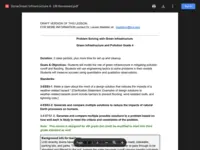Problem Solving with Green Infrastructure
https://drive.google.com/file/d/1R4l8vcsSuegloNR5Ij2_e3zfAolL-7xf/view
https://drive.google.com/file/d/1R4l8vcsSuegloNR5Ij2_e3zfAolL-7xf/view
Lauren Madden
In this activity, students design a watershed and test how runoff is impacted based on human design decisions.
This learning activity takes two 50 minute class periods.
Learn more about Teaching Climate Literacy and Energy Awareness»Grade Level
We feel that the grade level could be 4-8, rather than just grade 4.
Online Readiness
Topics
Climate Literacy
This Activity builds on the following concepts of Climate Literacy.
Click a topic below for supporting information, teaching ideas, and sample activities.
Notes From Our Reviewers
The CLEAN collection is hand-picked and rigorously reviewed for scientific accuracy and classroom effectiveness.
Read what our review team had to say about this resource below or learn more about
how CLEAN reviews teaching materials
Teaching Tips | Science | Pedagogy |
Technical Details
Teaching Tips
- Excellent hands-on lesson to discuss green infrastructure.
- Educators might want to incorporate the resources given into the lessons more. For example, showing a video of a flood, or showing pictures of GI examples (rain barrels, solar panels, etc.).
- It would be interesting to discuss rainfall for specific geographic areas.
About the Content
- Students are engaged in engineering their own scientific model of green infrastructure for their watershed in an attempt to mitigate pollution and runoff.
- Students learn about the importance of green infrastructure (GI, i.e., recharges the ground water and conserves water). Using various materials students make observations about how their models perform during an assimilated rainstorm.
- Background materials are clearly identified and useful.
- Passed initial science review - expert science review pending.
About the Pedagogy
- In this activity, students are able to test and build watersheds.
- There is a second day where students scaffold their learning by retesting methods that worked but with a budget constraint. This lesson plan and teaching sequence is a great way to engage students in design.
- This resource could be two separate lessons, the first focused on creating a GI model and the second working with financial constraints of building materials/budget.
- Neither lesson is super well developed but necessary information is given such as background information, a list of vocabulary, step-by-step instructions on how to create a GI model, and examples of costs of materials. Students are involved in hands-on learning by creating their own GI models.
- This resource engages students in using scientific data.
See other data-rich activities








